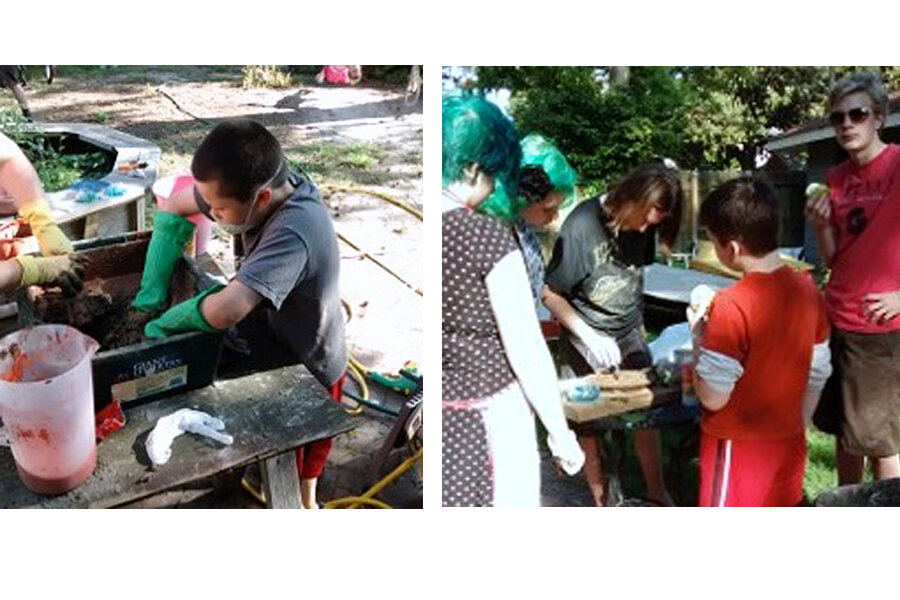National Gardening Exercise Day: Families can dig in together
Loading...
Parents can combine exercise, spring cleaning, yard chores, and crafts to create a family-friendly National Gardening Exercise Day celebration that will even get teens and young adults excited about being in the mix.
My weight loss smartphone app surprised me by revealing that gardening is not only emotionally therapeutic, but builds muscles and burns loads of calories.
The other day, I learned how hard I was working when I read the estimated calories burned after I inputted into the app all the hours I spent weeding, digging, spading, planting, pruning, mowing, raking, and walking the wheelbarrow around the yard.
Yet, more than just this mom’s personal peace and physical exercise, this national day helps families exercise their creativity and team work in the creation of spaces that can really grow on you.
While kids often have a natural aversion to hard work and exercise, this day offers kids a chance to get dirty, creative, and perhaps learn a few things about gardening in the process.
I am always on the lookout for ways to get my four sons out into the fresh air to both enjoy nature and help me to haul, trim, mow, prep, and plant the spaces around our Norfolk, Va., home.
Since the day we bought our home 10 years ago, the front lawn has been one big weed festival that required constant mowing as the clover, dandelions, and crabgrass has reached ever increasing heights.
This season, our neighbors, unintentionally, inspired a total yard and garden overhaul at our house when they decided to ditch their old green chain link fence and install a lovely new metal model.
That meant laboriously digging up the ancient rows of Liriope – a very common, low, grass-like, flowering plant that originally hails from East Asia, but seems to populate nearly every garden near our home.
In a burst of optimism, I asked the neighbor if I could have the many rows of plants they intended to discard. They swiftly agreed.
So began the project that at first was mine alone, but has now attracted three of my four sons and their friends much in the way the character Tom Sawyer once got an entire neighborhood of kids to come whitewash his Aunt Polly’s fence.
The boys gleefully helped me turn over the entire front yard once they cottoned-on to the fact that meant an end to mowing in the Virginia heat.
I set my son Quin, 10, on a mission of exploration on the internet to find easy ways to plant things.
He came up with using toilet paper laid down in rows with a seed placed in the center of each square with a second layer of toilet paper on top, all of which gave us straight rows and seeds the birds could not easily pilfer.
However, once things began to grow, the boys lost interest.
That changed when a sculptor pal, May Britton, generously let me choose some of her castoffs to add to the new landscape.
She also gave me a 90 pound bag of Portland cement and the suggestion to look up ways to make our own garden sculptures.
Again, I put Quin to work and this time, using Pinterest, he and I found a fund project that mixes the Portland cement with either Perlite or Vermiculite, sand and water (one measure, i.e. a child’s beach pail, of each) to make a lightweight crafting mix called Hypertoufa (also known as Hypertufa). We found a good recipe online that worked for us.
Any activity that involves hauling cement, sand, and water with the upper body, and the exertion of hand mixing them together is prime fodder for National Gardening Exercise Day.
This is like making mud pies that harden.
The boys quickly saw the merit in bringing their friends and girlfriends over for a day of messy, crafty fun that would result in permanent keepsakes from the day.
They collected all sorts of broken pots, toys, and stray items to use as either molds for their sculptures or decoration.
We also made a trip to the dollar store to get shiny glass beads and pebbles as well as plastic bowls to use as molds.
Our first project was filling rubber gloves with the mix and posing them to make everything from zombie hands breaking up through the dirt to cupped hands that hold small plants.
Then we began making bowls with the glass beads inset in patterns which we later flipped upside down and set into the garden atop some old terra cotta pipes as giant mushrooms and toadstools.
Then came the trolls, and a whole new world of family fun ensued.
“Dude, we should call your yard the Internet, it has so many trolls in it,” said Gabe, 15, one of our son Avery’s friends who came by yesterday to see what new additions there are since our first Hypertoufa session.
We will be doing this again for National Garden Exercise Day, only adding more neighbors and their kids to the fun and often frenzied mix.
I think we’ll call it “Hyper-too-fun” from now on and do it much more often than just once a year.






